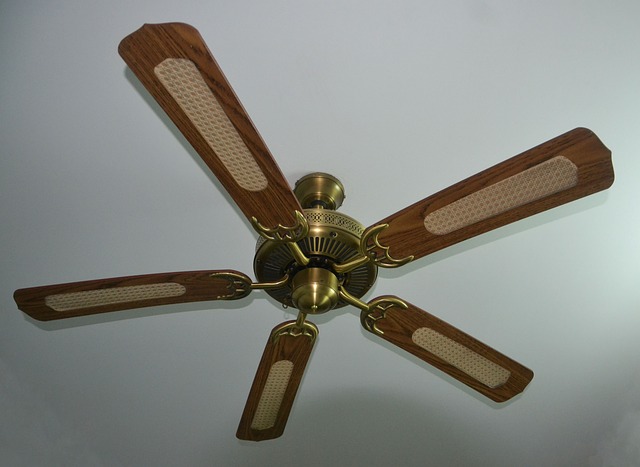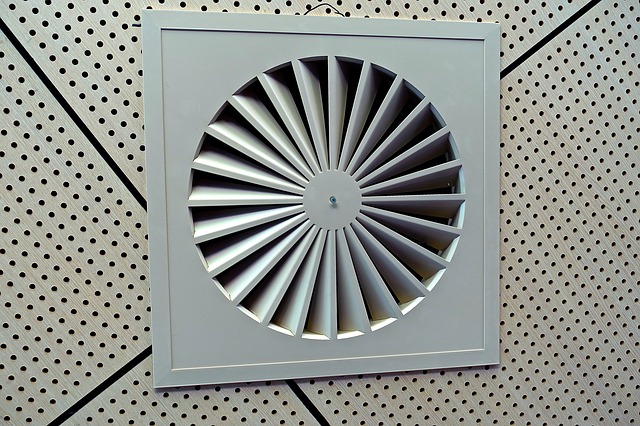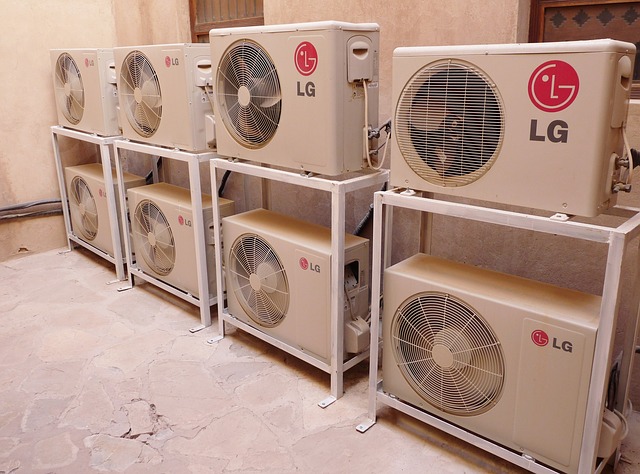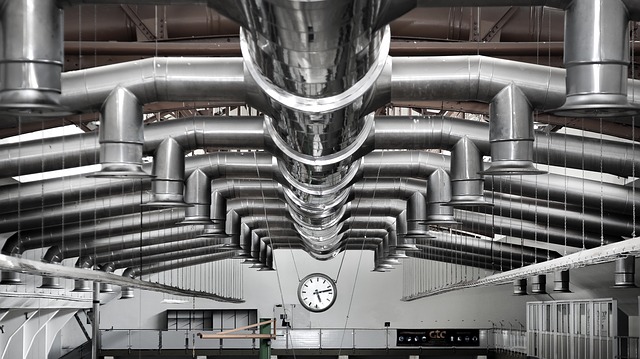Mechanical ventilation of buildings
Contents |
[edit] Introduction
Ventilation is necessary in buildings to remove ‘stale’ air and replace it with ‘fresh’ air:
- Helping to moderate internal temperatures.
- Helping to moderate internal humidity.
- Replenishing oxygen.
- Reducing the accumulation of moisture, odours, bacteria, dust, carbon dioxide, smoke and other contaminants that can build up during occupied periods.
- Creating air movement which improves the comfort of occupants.
Very broadly, ventilation in buildings can be classified as ‘natural’ or ‘mechanical’.
- Mechanical (or forced) ventilation is driven by fans or other mechanical plant.
- Natural ventilation is driven by pressure differences between one part of a building and another, or pressure differences between the inside and outside. For more information see Natural ventilation.
Natural ventilation is generally preferable to mechanical ventilation as it will typically have lower capital, operational and maintenance costs. However, there are a range of circumstances in which natural ventilation may not be possible:
- The building is too deep to ventilate from the perimeter.
- Local air quality is poor, for example if a building is next to a busy road.
- Local noise levels mean that windows cannot be opened.
- The local urban structure is very dense and shelters the building from the wind.
- Privacy or security requirements prevent windows from being opened.
- Internal partitions block air paths.
- The density of occupation, equipment, lighting and so on creates very high heat loads or high levels of contaminants.
Some of these issues can be avoided or mitigated by careful design, and mixed mode or assisted ventilation might be possible, where natural ventilation is supplemented by mechanical systems.
[edit] Types of mechanical ventilation
Where mechanical ventilation is necessary it can be:
- A circulation system such as a ceiling fan, which creates internal air movement, but does not introduce fresh air.
- A pressure system, in which fresh outside air is blown into the building by inlet fans, creating a higher internal pressure than the outside air.
- A vacuum system, in which stale internal air is extracted from the building by an exhaust fan, creating lower pressure inside the building than the outside air.
- A balanced system that uses both inlet and extract fans, maintaining the internal air pressure at a similar level to the outside air and so reducing air infiltration and draughts.
- A local exhaust system that extracts local sources of heat or contaminants at their source, such as cooker hoods, fume cupboards and so on.

|

|

|
[edit] Typical mechanical ventilation systems for commercial buildings
In commercial developments, mechanical ventilation is typically driven by air handling units (AHU) connected to ductwork within the building that supplies air to and extracts air from interior spaces. Typically AHU comprise an insulated box that forms the housing for; filter racks or chambers, a fan (or blower), and sometimes heating elements, cooling elements, sound attenuators and dampers. In some situations, such as in swimming pools, air handling units might include dehumidification. See Air handling units for more information.
Where mechanical ventilation includes heating, cooling and humidity control, this can be referred to as Heating Ventilation and Air Conditioning (HVAC). See Heating Ventilation and Air Conditioning for more information.
Extracting internal air and replacing it with outside air can increase the need for heating and cooling. This can be reduced by re-circulating a proportion of internal air with the fresh outside air, or by heat recovery ventilation (HRV) that recovers heat from extract air to pre-heat incoming fresh air using counter-flow heat exchangers. See Heat recovery ventilation for more information.
The design of mechanical ventilation systems is generally a specialist task, undertaken by a building services engineer. Whilst there are standards and rules of thumb that can be used to determine air flow rates for straight-forward situations, when mechanical ventilation is combined with heating, cooling, humidity control and the interaction with natural ventilation, thermal mass and solar gain, the situation can quickly become very complicated.
This, along with additional considerations, such as the noise generated by fans, and the impact of ductwork on acoustic separation means it is vital building services are considered at the outset of the building design process, and not seen as an add-on.
See Building services engineer for more information.
[edit] Building management systems
Mechanical ventilation may be controlled by a building management system (BMS) to maximise occupant comfort and minimise energy consumption. Regular inspection and maintenance is necessary to ensure that systems are operating optimally and that occupants understand how systems are operated.
See Building management system for more information.
[edit] Building regulations requirements
Ventilation in buildings is regulated by Part F of the building regulations. Approved document F includes standards for ventilation and air quality for all buildings and requirements for the prevention of condensation. The types of ventilation covered include; mechanical, passive stack, background and purge (rapid).
It is supported by the Domestic Ventilation Compliance Guide, which provides detailed guidance about the installation, inspection, testing, commissioning and provision of information when installing fixed ventilation systems in new and existing dwellings.
See Approved document F for more information.
[edit] Related articles on Designing Buildings
- Air conditioning.
- Approved Document F.
- BREEAM Potential for natural ventilation.
- BSRIA Indoor Air Quality TG 12/2021.
- Building management systems.
- Building services.
- Complex system.
- Computational fluid dynamics.
- Condensation.
- Constant air volume.
- Convection.
- Cross ventilation.
- Dehumidification.
- Displacement ventilation.
- Ductwork.
- Heat recovery.
- Humidity.
- HVAC.
- Mechanical smoke ventilation.
- Minimum efficiency reporting value MERV.
- Mixed-mode ventilation.
- Natural ventilation.
- Passive building design.
- Solar chimney.
- Stack effect.
- Thermal comfort.
- Types of ventilation.
- Variable air volume VAV.
- Ventilation.
Featured articles and news
Homes England supports Greencore Homes
42 new build affordable sustainable homes in Oxfordshire.
Zero carbon social housing: unlocking brownfield potential
Seven ZEDpod strategies for brownfield housing success.
CIOB report; a blueprint for SDGs and the built environment
Pairing the Sustainable Development Goals with projects.
Types, tests, standards and fires relating to external cladding
Brief descriptions with an extensive list of fires for review.
Latest Build UK Building Safety Regime explainer published
Key elements in one short, now updated document.
UKGBC launch the UK Climate Resilience Roadmap
First guidance of its kind on direct climate impacts for the built environment and how it can adapt.
CLC Health, Safety and Wellbeing Strategy 2025
Launched by the Minister for Industry to look at fatalities on site, improving mental health and other issues.
One of the most impressive Victorian architects. Book review.
Common Assessment Standard now with building safety
New CAS update now includes mandatory building safety questions.
RTPI leader to become new CIOB Chief Executive Officer
Dr Victoria Hills MRTPI, FICE to take over after Caroline Gumble’s departure.
Social and affordable housing, a long term plan for delivery
The “Delivering a Decade of Renewal for Social and Affordable Housing” strategy sets out future path.
A change to adoptive architecture
Effects of global weather warming on architectural detailing, material choice and human interaction.
The proposed publicly owned and backed subsidiary of Homes England, to facilitate new homes.
How big is the problem and what can we do to mitigate the effects?
Overheating guidance and tools for building designers
A number of cool guides to help with the heat.
The UK's Modern Industrial Strategy: A 10 year plan
Previous consultation criticism, current key elements and general support with some persisting reservations.
Building Safety Regulator reforms
New roles, new staff and a new fast track service pave the way for a single construction regulator.























